Physical Therapy After Hip Replacement
Your full recovery from your total hip replacement surgery is going to take several months. This website will help you understand your recovery. Guidelines are included which discuss precautions to protect your new joint, exercises that increase you hip strength, and activities of daily living that will help you become an active partner in your care and recovery.
Guidelines to Protect Your New Hip Joint
Your hip surgery did not involve cutting muscles. Motion is usually improved after surgery. Most patients can place all of their weight on the new hip. Having the hip dislocate or "pop out of socket" is almost unheard of with modern implants and surgical techniques. Because of these advances, we are more relaxed in our hip precautions although you may hear of precautions and restrictions in motion that other surgeons use. Below are Dr. Hickman's general guidelines for the first three weeks to help ease recovery of soft tissues.
- Extremes in motion are discouraged for the first three weeks.
- You may bend past 90 degrees if your elbows are inside your knees. Do not twist or rotate your knee inward as you bend.
- It is okay to cross your legs.
- You may sleep on the side of your new hip while in bed. You may place a pillow between your legs for comfort.
- If you are riding in a car, stop every hour or so and walk around for a few minutes.This will help the circulation in your legs and keep your muscles from stiffening up.
- Check with Dr. Hickman when you can resume driving after your surgery.
- Talk to Dr. Hickman about when sexual activity may be resumed and what positions should be avoided.
Our team will teach you in the hospital to use a walker or crutches before you go home. You will quickly progress to a cane. Some patients may not be allowed to put all their weight on the hip immediately. Dr. Hickman will tell you how much weight you can safely put on your new hip. At your three week checkup, Dr. Hickman will tell you if your hip has healed enough to progress to sports or other activities.
Your balance might be shaky for a while.
- Use handrails on steps.
- Use low-heeled or flat shoes.
- Avoid wet or waxed floors.
- Keep your floors free of items that could trip you. Throw rugs or small objects should be kept off of the floor for your safety.
- Watch for pets or other animals that could get in your way.
- Avoid ice or snow.
Adaptive Equipment After Total Hip Replacement
Most patients do not require aids postoperatively, but you patients may benefit from several devices to make your daily activities easier and safer. As your soft tissues heal (though preserved they are irritated), these devices may make certain activities more comfortable. Dr. Hickman and your physical therapist will recommend the equipment that best suits your needs.

Seat / Shower Bench: This seat allows you to sit while bathing and provides you safety while you are in the shower.
Seat Cushion: Cushions are used to elevate the seat height of a chair, couch, car, or other surfaces.

Elevated Toilet Seat: This device is attached to your toilet seat to elevate its height.

Reacher: A reacher is used to pick up items off the floor and help you with dressing.
Dressing Stick: This device has a hook on one end and a pusher on the other end. It is used to help put on pants, skirts, pull up zippers, etc.
Sock Aid: This aid helps you safely put on your sock.

Long-handed Bath Sponge: This sponge helps you clean hard to reach areas while bathing.
Long-Handled Shoe Horn: This shoe horn is attached to long stick and allows you to put on your shoes while sitting or standing.
Managing Activities of Daily Living Following Surgery
Walking with Crutches
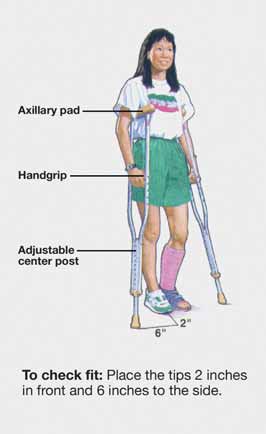
Crutch Safety
- The pressure or weight goes on your hands and not on your armpits. Nerve damage can result if weight is placed on the armpits for a long period of time.
- Keep your elbows close to your side to help keep the crutches against your ribs.
- Your crutch tips should be 2 to 3 inches out to the side of your feet so you do not trip on your crutches
- There should be a slight bend in your elbow when holding onto the crutches (15 to 20 degrees).
- Take your time and do not try to walk too fast.
- Keep your head up and look ahead. Do not look at your feet when walking.
- When walking on carpet, you must pick up your crutches and injured leg more than when you walk on tile or linoleum floors.
- Remove all throw rugs from the floor to keep from slipping and falling.
You may place as much weight on your operated leg as you can tolerate, if told so by Dr. Hickman. Use the crutches to improve your balance and safety, as well as to favor the operated leg when it is painful. Always use a handrail if one is available for stairs and curbs.

Going up with Handrail
- Place both crutches under your arm on the injured side.
- Grasp the handrail with your other hand, if possible.
- Bring your good leg up to the next step. Let the injured leg trail behind.
- Straighten your good leg and bring the crutches and injured leg up.
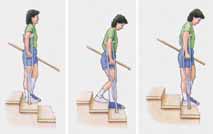
Going Up without Handrail
- Keep the crutches on the stair you are standing on.
- Support your weight between your crutches.
- Bring your good leg up to the next step. Let your injured leg trail behind.
- Straighten your good leg and bring the crutches and injured leg up.
Going Down with Handrail
- Put the crutch on the lower step.
- Lower your injured leg down to the lower step.
- Support your weight between your crutch and handrail.
- Move your good foot to the lower step
- Put the crutches on the lower step.
- Support your weight between your crutches.
- Bring your injured leg down to the lower step. Let your good leg trail behind.
- Bring your good leg down.
Chair Transfer
Avoid recliners and soft couches until otherwise told by Dr. Hickman. Stiff-backed chairs with armrests are ideal to sit in. If the seat is low, you may place 1 or 2 pillows in the chair to elevate the seat and facilitate transfers
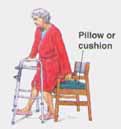

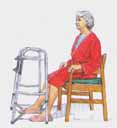
- Back up to the chair until you feel both Iegs touching the chair.
- Slide your operated leg out in front of you as you reach back with one hand for an armrest.
- Lower yourself slowly, keeping your operated leg straight out. Once seated, bend your knee comfortably, or keep it straight.
- When getting up, scoot your operated leg out in front of you.
- Push up using the armrests, keeping your operated leg out in front of you.
Car Transfers
The front seat is preferable because it generally has more leg room, can be adjusted for comfort, and can allow the rider to more easily wear a seat belt.
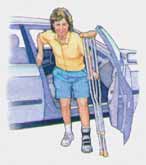
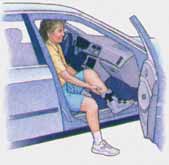
- Make sure the seat is as far back as possible. Back up to the car with your walker or crutches. Put your operated leg out in front of you.
- Lower yourself slowly to the seat. You may roll the window down and use the car doorframe, along with the headrest, to support yourself as you sit.
- Scoot back into the seat, then swing your legs into the car. If the seat is low, recline the back slightly or put a pillow on the seat to sit on.
- To get in the back seat in a semi-reclining position. You will need to use your arms and non-operative leg to scoot yourself back farther onto the seat.
Putting on Pants
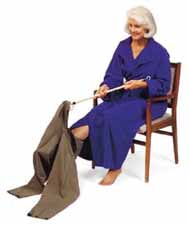
- Slip the underwear or pant leg over your operated leg first by lowering the reacher toward the floor by your foot.
- Repeat for your non-operated leg.
- Pull the underwear or pants up over your knees.
- Stand with the walker or crutches and pull the pants or underwear up.
- When undressing, take the pants or underwear off of your non-operated leg first.
Putting on Shoes
Wear slip-on shoes or shoes with Velcro straps so that you will not have to bend over to put the shoes on and tie the laces. If you are having difficulty, use the long-handled shoe horn or reacher to put on and take off your shoes.
Exercises
Most patients after a hip replacement do not require formal physical therapy. Walking is the best exercise after surgery, beginning with short, frequent walks. The day of surgery, the physical therapist will get you out of bed for the first time. The therapist will help you walk with a walker or crutches as you are able. Each day the amount of walking will increase as you can tolerate. Before you go home, the physical therapist will teach you how to climb stairs safely to protect your new hip.
Additional exercise can help you regain the strength in your hips and legs so you can walk more easily. Below are some basic exercises that should be performed until you can do 3 sets of 10 repetitions very easily. Your therapist at the hospital will also review a home exercise program with you before you are discharged.
Ankle Pumps: This strengthens your calf muscles in your lower leg.
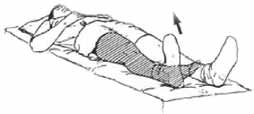
- Lie on your back.
- Bend your ankle and pull your foot and toes towards your head.
- Push your foot back down and point your toes away from you as far as possible, like you are pushing on the brake pedal of a car.
- Repeat with both legs 10 times every 2 hours throughout the day.
Quad Setting: This exercise helps your upper leg or thigh muscles.
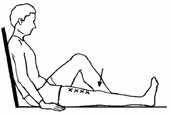
- Tighten the muscles of your thigh.
- Keep your knee straight. Push your knee down into the bed, having your kneecap move upward toward your hip.
- Think about trying to raise your heel ½ inch off the bed.
- Hold for a count of 5 and then relax.
- Repeat with the other leg.
- Alternate legs for 10 repetitions on each side 3 times a day.
Gluteal Setting
- Squeeze your buttocks together. Hold for a count of
- Relax and repeat. Perform a total of 10 repetitions 2 times a day.
Avoiding Problems After Surgery
Blood Clot Prevention: Follow your Dr. Hickman's instructions carefully to minimize the potential of blood clots which can occur during the first several weeks of your recovery. Warning signs of possible blood clots in your leg include:
- Increasing pain in your calf or thigh.
- Tenderness or redness above or below your knee.
- Increasing swelling in your entire leg.
Warning signs that a blood clot has traveled to your lung include:
- Sudden increased shortness of breath.
- Sudden onset of chest pain.
- Localized chest pain with coughing.
Notify Dr. Hickman immediately if you develop any of these signs.
Preventing Infection: The most common causes of infection following total hip replacement surgery are from bacteria that enter the bloodstream during dental procedures, urinary tract infections, or skin infections. These bacteria can lodge around your hip replacement and cause an infection.
Following your surgery, you should take antibiotics prior to major dental work or any surgical procedure that could allow bacteria to enter your bloodstream.
Warning signs of a possible hip replacement infection are:
- Persistent fever (higher than 100 degrees orally).
- Shaking chills.
- Increasing redness, tenderness or swelling of the knee wound.
- Drainage from the hip wound.
- Increasing hip pain with both activity and rest.
Notify Dr. Hickman immediately if you develop any of these signs.

